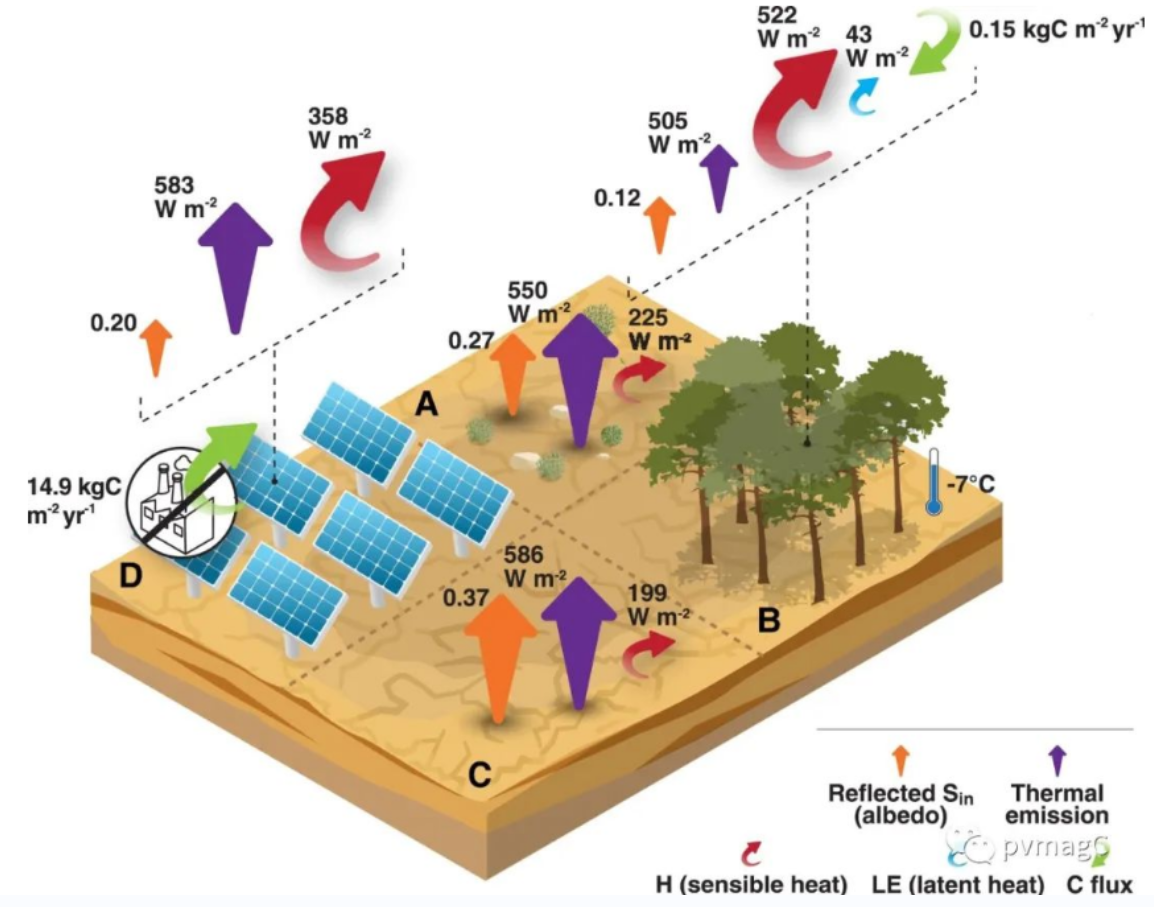In response to the warming caused by the darkening of the land, Israeli scientists have calculated the time required for photovoltaic plants and afforestation projects to offset the effects of such warming. The calculations show that in arid regions, photovoltaic farms may be more than 50 times more efficient in reducing carbon emissions than afforestation.

Image credit: Weitzman
Land status affects the effectiveness of carbon reduction. Mid-summer transition from desert to afforested area (A, B) and from desert to photovoltaic field (C, D) in an arid region.
Institute of Science, PNAS Nexus, Creative Commons CC BY 4.0 Researchers at the Weizmann Institute of Science in Israel compared the effectiveness of both ground-mounted photovoltaic (PV) installations and afforestation in combating climate change, and found that the former was superior.
In their simulations, the scientists created a new metric they call "break-even time" (BET). It calculates how long it might take for the two technologies to have an impact on carbon emissions and offset the effects of warming due to land darkening.
"Photovoltaic power generation can significantly reduce anthropogenic carbon emissions. Afforestation can play an important complementary role in climate change mitigation efforts by providing a direct means of actively removing atmospheric carbon," the researchers said, "however, both have high demands on land area, which may lead to competition for land in forest-friendly areas."
To test which land use was more effective at reducing carbon, the scientists took a series of measurements in southern Israel. They said the drylands here are highly representative. "Drylands make up a large portion of the Earth's land surface, and nearly half of them are semi-arid areas, which also raise concerns about potential afforestation projects. However, these drylands may also be heavily utilised for the construction of utility-scale photovoltaic farms," the group explained.
Research findings
The impact of photovoltaic installations on surface temperatures was studied in a photovoltaic power plant in a hyper-arid region of the Arava Valley, Israel, adjacent to the kibbutz Ketura. The PV farm covers an area of 75,600 square metres and has an installed capacity of 4.9 MW, and the academics compared the results obtained with background measurements in the same area.
According to their measurements, the sensible heat of the PV plant is 359 W per square metre, compared to 199 W per square metre for the background measurements in the area surrounding the plant, with an albedo of 0.2 and 0.37, respectively, which was calculated to be a reduction of 14.9 kilograms of carbon per square metre of PV plant per year.
Regarding the effect of afforestation on heat levels, the scientists made measurements in the Yatir Forest on the northern edge of the Negev Desert in Israel. The forest covers an area of 2,800 hectares, and the main tree species is Jerusalem pine. The scientists compared the data collected from here with data collected from the desert background.
In this case, the measurements showed that the sensible heat in the afforested area was 522 W per square metre, and in the background area 225 W per square metre. the albedo of the forest floor was 0.12, and that of the desert was 0.27. the rate of carbon sequestration per square metre of the forested area, due to photosynthesis, was calculated to be 0.15 kilograms per year. the results of the study show that the forested area has a carbon sequestration rate of 0.15 kilograms per square metre of the forested area
"The results of the study show that in arid areas, photovoltaic plants are more than 50 times more efficient in reducing carbon than afforestation," the researchers said. At the same time, they said that in arid regions, it takes about 1.4 to 3.6 years for a PV plant to reach break-even time, while it takes 94 to 175 years for afforestation to reach break-even time.
Temperate and tropical climates
In addition, the researchers used this methodology to calculate the break-even times for photovoltaic power plants and afforestation in temperate and tropical climates, based on data obtained from previous studies conducted in Germany and Panama. The results of the study were published in an article in the journal PNAS Nexus titled "Photovoltaic farms substantially outperform afforestation for carbon reduction efficiency in global climate change mitigation strategies".
They added: "Despite the significant improvement in the relative efficiency of afforestation compared to photovoltaic (PV) plants in wetter climates, the break-even time (BET) of PV plants is still about 20 times faster than that of afforestation." They noted that in tropical and temperate climates, the BET for PV plants is less than one year, compared to 18.5 years for temperate afforestation and 15.4 years for tropical afforestation.
"Photovoltaic power generation reduces much more carbon emissions than afforestation absorbs," they conclude, "however, the active removal of carbon already emitted in the past and its possible long-term storage as biomass and soil organic matter is an important advantage of afforestation. Forests offer many other ecological benefits compared to this purely climatic view."
Source: pvmagC













